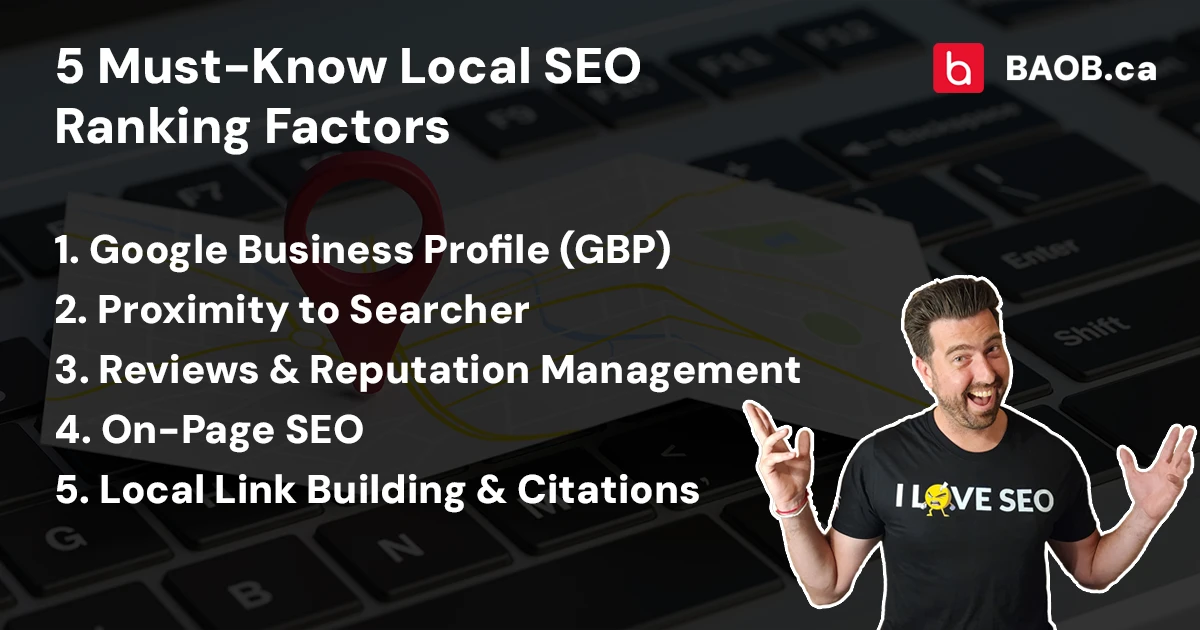When potential customers search for a service in their area, what determines which businesses appear at the top of Google? The answer lies in Local SEO ranking factors—the signals Google uses to decide who gets visibility in local search results and Google Maps.
You might assume that being the best at what you do is enough to rank well. But in reality, Google doesn’t just reward expertise—it prioritizes businesses that optimize for local search.
That’s why you’ll often see competitors with fewer credentials, lower ratings, or less experience outranking more qualified businesses. They’ve simply aligned their Google Business Profile, website, and online reputation with the factors that matter most for local SEO.
So if you want more leads and visibility, understanding Local SEO ranking factors is essential. This guide will break down how Google ranks local businesses and what you need to focus on to stay ahead.
What is Local SEO?
Local SEO is the art and science of getting your business to appear in search results when people look for services in your area. While traditional SEO focuses on ranking high in global or national searches, Local SEO is about dominating your city, region, or service area.
Think of it this way:
- Traditional SEO is like being the best restaurant in the country—great for prestige, but not helpful if people can’t find you in their own town.
- Local SEO is like being the best burger joint on Main Street—where real, paying customers can actually walk through the door.
Why Does Local SEO Matter?
There’s no denying it—Google’s algorithm is volatile. One day, you’re ranking at the top, and the next, a competitor you’ve never heard of appears above you. The landscape is always shifting, and traditional SEO can feel like an uphill battle.

As you can see, Google Search and Google Maps continues to dominate our local search experience with more than half of consumers looking up information about local businesses. Which is good news, because Local SEO is one of the most consistent and high-impact strategies for driving real revenue.
For example, in 2024, I helped a local business owner in Canada generate $100,000 in new revenue—all directly from Google Search. They weren’t running paid ads. They weren’t spending thousands on social media. We simply optimized their website for Local SEO, and the results spoke for themselves.
If you’re wondering whether Local SEO still works, the answer is yes. And the data backs it up:
- 46% of all Google searches have local intent. (Search Engine Roundtable)
- 76% of consumers who search “near me” visit a business within a day. (Google)
- 60% of mobile users contact a business directly from search results. (Google)
In short: if you’re not showing up in local searches, you’re losing potential clients to competitors who are.

How Google Decides Who Ranks in Local Search
Google has publicly stated that local rankings are based on three core factors:
Local results are based primarily on relevance, distance, and prominence. A combination of these factors helps us find the best match for your search.
These three local SEO ranking factors determine which businesses appear at the top of local search results and Google Maps. Let’s break them down:
- Relevance – How well does your business match what the searcher is looking for? If someone searches for “family law attorney” and your Google Business Profile only says “legal services,” you may not appear in the results.
- Distance – Google prioritizes businesses closest to the searcher’s location. However, a more relevant business can outrank a closer but less optimized competitor.
- Prominence – This is about trust and reputation. Google considers:
- Your reviews and ratings (more & better reviews = higher rankings).
- Your website authority (do other sites link to you?).
- Your brand recognition (are people searching for you by name?).
This means ranking higher in local search isn’t about luck—it’s about strategy.
5 Types of Local SEO Ranking Factors
Now let’s look at the key local SEO ranking factors and what you can do to outrank competitors and attract more customers.

1. Google Business Profile (GBP)
If you want to rank in local search, your Google Business Profile (GBP) isn’t optional—it’s essential. This is the first thing Google looks at when determining which businesses appear in the Google Maps Pack and local search results. If your profile is incomplete, inaccurate, or inactive, you’re giving competitors an easy win.
Google prioritizes businesses with fully optimized profiles—and the data backs this up:
- 42% of people who conduct a local search click on results inside the Google Maps Pack. (Backlinko)
A well-optimized GBP sends strong signals to Google, reinforcing what your business does, where it’s located, and why it’s relevant to potential customers.
How to optimize your Google Business Profile:
- Claim and verify the profile. Unverified listings won’t rank.
- Complete every section, including business name, category, address, phone number, website, hours, and services. Incomplete profiles get less visibility.
- Choose the right primary category. This has the most impact on rankings. A specific category like “Family Law Attorney” is better than just “Lawyer.”
- Add secondary categories to cover additional services.
- Upload high-quality images and videos. Listings with photos get 42% more requests for directions and 35% more website clicks.
- Write a business description that includes relevant keywords naturally.
- Post updates regularly. Sharing promotions, events, and business updates signals activity to Google.
- Encourage customer reviews and respond to all of them. More and better reviews improve rankings.
A well-optimized GBP helps Google understand what a business does, where it’s located, and why it’s relevant to searchers. Without it, competing for local rankings is nearly impossible.

2. Proximity to Searcher
Proximity is, I believe, one of the strongest local SEO ranking factors. When someone searches for a service, Google prioritizes businesses that are closest to the searcher’s location—but proximity alone isn’t always enough to rank at the top.
A well-optimized business that’s slightly farther away can outrank a closer competitor if it has higher relevance and prominence.
For businesses in competitive industries, ranking well in multiple areas isn’t as simple as having a physical address. Google calculates proximity based on the searcher’s location at the time of the search, meaning that two people searching for the same service from different parts of the city may see entirely different results.
How to improve local rankings despite proximity limitations:
- Optimize for service areas by listing nearby cities and neighborhoods on your website and Google Business Profile.
- Use location-based keywords in content, headings, and metadata. Example: “IT Support in Downtown Toronto” instead of just “IT Support.”
- Create location-specific landing pages for each major service area, rather than relying on a single generic page.
- Encourage check-ins and reviews from customers in different locations to reinforce a broader service range.
- Ensure consistent NAP (Name, Address, Phone Number) information across all directories to avoid conflicting signals.
Proximity is something businesses can’t directly control, but strong local optimization can help extend reach beyond just the immediate area. Businesses that focus on content, service areas, and engagement can improve rankings even when they aren’t the closest option.
3. Reviews & Reputation Management
Google values customer feedback more than anything a business says about itself. Reviews are a direct trust signal, influencing rankings, credibility, and conversions. A business with more high-quality reviews will almost always rank higher than one with fewer or lower-rated reviews—especially in competitive industries.
88% of consumers trust online reviews as much as personal recommendations. A strong reputation doesn’t just improve rankings; it directly impacts whether people choose your business over competitors.
Google considers multiple factors when evaluating reviews:
- Quantity – More reviews indicate an active, well-established business.
- Quality – Higher star ratings improve rankings and customer trust.
- Recency – Fresh reviews signal an engaged customer base.
- Diversity – Reviews across Google and third-party sites (Yelp, Facebook, industry-specific directories) add credibility.
- Engagement – Responding to reviews (both positive and negative) improves rankings and shows professionalism.
How to Build and Manage Reviews for SEO Impact
- Ask customers for reviews regularly – Google prioritizes businesses with a steady flow of recent reviews.
- Make it easy – Send direct links via email, SMS, or QR codes.
- Respond to every review – Acknowledging feedback signals engagement and boosts visibility.
- Use keywords in responses – If a customer praises your “business coaching services in Vancouver,” reinforce it in your response: “We’re glad you had a great experience with our business coaching in Vancouver!”
- Never fake or incentivize reviews – Google actively removes suspicious reviews, and penalized listings can be hard to recover.
A strong review strategy improves local SEO rankings, reputation, and conversions. Businesses that actively manage and respond to reviews will always have an edge in local search.
4. On-Page SEO for Local Businesses
Google relies on website content to understand what a business offers and where it operates. Without strong on-page SEO, even the best Google Business Profile won’t be enough to compete in local search.
Local businesses that invest in well-structured, optimized website content consistently rank higher in both organic search results and the Local Pack. Having a dedicated page for each service is one of the most significant ranking factors for local organic SEO.
How to optimize on-page SEO for local rankings:
- Create service-specific pages – Instead of a generic “Services” page, build dedicated pages for each service. Example: “Estate Planning Lawyer in Toronto” instead of just “Legal Services.”
- Use location-based keywords – Naturally integrate city or neighborhood names into headings, URLs, and metadata. Example: “HVAC Repair in Calgary” instead of just “HVAC Repair.”
- Optimize title tags and meta descriptions – These should include primary keywords and a location reference to improve click-through rates.
- Ensure NAP consistency – Display the business name, address, and phone number on every page, preferably in the footer.
- Refresh Old Pages –
- Use schema markup – Local business schema helps Google understand location, services, and contact details more clearly.
- Improve internal linking – Link between service pages and location pages to strengthen relevance for local searches.
Well-optimized website content helps Google match a business with relevant local searches. Without it, even a strong Google Business Profile and review strategy won’t be enough to compete effectively.

5. Local Link Building & Citations
Backlinks remain one of the strongest ranking signals in SEO, and local businesses need locally relevant backlinks to build authority in Google’s eyes. While general link-building tactics apply, local SEO requires a more strategic approach—earning links from other businesses, industry sites, and local organizations.
Citations, on the other hand, are mentions of a business’s name, address, and phone number (NAP) on other websites. They used to be a critical local SEO ranking factor, but modern factors relies more on quality backlinks and strong on-page signals than NAP consistency alone.
How to build local links and citations effectively:
- Get listed on authoritative local directories – Google Business Profile, Yelp, Better Business Bureau, and industry-specific directories.
- Earn backlinks from local businesses and organizations – Sponsoring events, partnering with local businesses, or getting featured in local media.
- Leverage industry blogs and guest posts – Contributing content to niche industry sites can strengthen authority.
- Engage with local press and PR opportunities – Being featured in local news or online publications adds credibility and boosts rankings.
- Check for duplicate or incorrect citations – Inconsistent business listings can create confusion, so audit and update listings as needed.
While citations still help establish legitimacy, earning high-quality local backlinks has a bigger impact on rankings than simply being listed in directories. A strong local link profile signals trust, authority, and relevance in competitive local search results.
The Future of Local SEO & Where It’s Heading
Local SEO ranking factors are constantly evolving, and businesses that stay ahead of the trends will have a competitive advantage. While Google’s ranking factors remain centered around relevance, distance, and prominence, the weight of each factor is shifting, and new signals are becoming more important.
Emerging trends shaping local search:
- AI & ChatGPT’s role in search – 86% of SEO professionals have integrated AI into their strategy, which includes automating repetitive tasks to spend more time on higher-level SEO activities (SEOProfy)
- Google’s shift toward engagement signals – Click-through rates, dwell time, and direct interactions (calls, messages) are playing a larger role in rankings.
- Multi-platform visibility – Younger consumers increasingly use Instagram (67%) and TikTok (62%) for local searches, meaning businesses need to establish a presence beyond Google. (SOCi)
- Voice search optimization – More users are searching for businesses using voice assistants, increasing the importance of natural language content.
- Google’s ongoing updates to GBP – New GBP features, like messaging, Q&A, and product listings, are making profiles more interactive and essential for engagement.
If you’re serious about getting more local customers and improving your search rankings, I can help. Whether you need a high-converting website, a Google Business Profile overhaul, or a custom Local SEO strategy, let’s make sure your business is the one customers find first.







